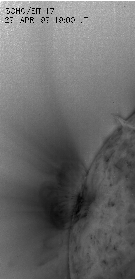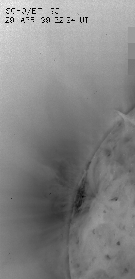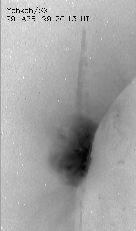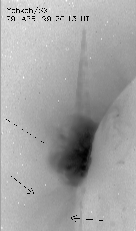 |
 |
 |
Presented below are two images from the Extreme Ultraviolet Imaging
Telescope (EIT) on the
SOHO solar observatory satellite,
and one from Yohkoh Soft X-ray Telescope (SXT).
The EIT images are taken in narrow EUV bands centered on 171 and 195 Angstroms,
respectively; the SXT image takes X-rays from a broad band of wavelengths
between 3 and 45 Angstroms. All three images are from 29-Apr-99, and show
the northeast limb of the Sun. We have presented them all in a grey-scale
color table, and reversed the colors so that the bright emission from hot
gas shows up dark in the images. This was done to emphasize the fainter
features, which tend to be more easily visible in a color-reversed image.
 |
 |
 |
In particular we're looking at the large active region on the east limb. All three images show the magnetic loops in the region, and we can use the images to understand the structure of the region.
Note however the SXT image doesn't seem to show any of the bright linear
"rays" above the active region, which show up so prominently in the EIT
images. If we squint (and enhance the contrast slightly) we can detect
some of these features in the SXT image: in the following image, arrows
mark some of the smaller linear features in the southern part of the image.
One can also detect (barely) that the emission is enhanced slightly to
the north of the dashed line, similar to the location of the structure
in the EIT images.
 |
Okay, so they're very different. So what? The differences might help us to make some inference about the nature of the bright rays. The EIT 171 channel has a peak response around 1 million Kelvins (MK), SXT around 2-3 MK, and 195 somewhere in between. So the presence of tall rays in 171 and 195, but not in SXT suggests a rather cool temperature. This reminds us of the plumes that EIT sees in the solar polar regions, described by DeForest & Gurman (1998, ApJ, 501, L217). However, DeForest & Gurman weren't talking about structures above active regions, but rather magnetically unipolar features extending upwards from coronal holes. The structures seen in the present case may be more like the "fan of rays" seen above some post-CME arcades; Svestka et al. discussed one in Solar Physics (1998, 182, 179), and their movie is linked here. SXT has seen several similar "arcade fans", but always associated with coronal mass ejections; the flare arcade of 20-jan-99, which was discussed briefly in a previous Weekly Nugget, is an example. We are not aware of a CME related to the 29-Apr-99 region, so this set of tall rays remains enigmatic. Ideas, anyone?
April 30, 1999: David McKenzie
(mckenzie@isass0.solar.isas.ac.jp)